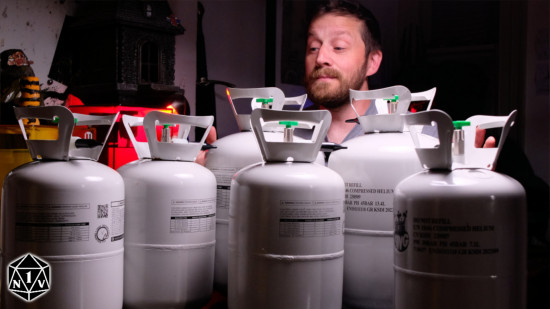Mini painter and model builder Michael Patterson, of YouTuber channel Nat 1 Videos, has successfully launched a Warhammer 40k Space Marine miniature into low orbit. He tells us how he achieved this feat using a weather balloon, help from his engineer brother Stephen, and a lot of messages to the British Civil Aviation Authority.
Stephen and Michael are “both nerds, but very different kinds of nerds”: while Michael builds DnD terrain, Lord of the Rings dioramas, and Warhammer 40k cosplay props for his YouTube channel, Stephen has a PhD from Imperial College and teaches engineering in London.
Stephen “runs a programme for his students where they launch small satellites called ‘can sats’ by using large weather balloons”, Michael says. The project to send a Space Marine into space “came about as a way for my brother and I to spend time together”, he explains, an activity that combined his “love of the miniature-based hobby” and his brother’s love “of sending stuff into the stratosphere”.
You can watch the project’s diaries, and the incredible footage of the Space Marine floating at the very limits of earth’s atmosphere, in the video below.

“Initially I thought that this project was going to be really easy”, Michael says, “I mean how hard can it be to fill a balloon with helium, strap a camera and a Space Marine to it and let it go?”. “It turns out it’s really complicated”, he admits, “Not just in the technical execution of it but also legally”.
There was a really substantial challenge getting permission from the civil aviation authority and air traffic control to line up with the weather. “What I thought would take about a month to complete, actually ended up taking a year”, Michael says, “with many different failed launch attempts before we actually ended up having a successful launch”.
He and his brother ran “probably close to a hundred different flight simulations and predictions over the course of that year”. “On the days that we had permission to fly, the balloon was set on a course to land in the sea”, a problem that recurred “over and over again”. He adds that “it really felt at times like we would never get it off the ground”.
The flight was filmed with a GoPro12. “We were determined that we wanted the highest possible footage quality with no pixelation”, Michael says, but “we initially did some test shots with the Space Marine in front of the camera and it honestly just looked a bit pants”.
He explains that “GoPros are designed for wide expansive shots with the fish eye lens making everything look wide and huge”, not at all suited for close up photography of a miniature. Thanks to sponsorship by miniature paint maker The Army Painter, they equipped the GoPro with a macros lens “which brought the focal point much closer”.
The camera was “built into a polystyrene box as part of the payload with all of the other weather experiments” that Stephen was including in the flight. “The polystyrene box acts as a way to stop all of the equipment from failing”, Michael explains, “because high altitude and low temperature is terrible for batteries”.
When it came time to launch, “you are under a lot of time pressure because Air Traffic control gives you a very small window of time to execute the launch”. That means “inflating the balloon” with just the right amount of helium, “getting all the experiments and instrumentation ready, making sure cameras are working and on, trackers working with signal”, and more.
But “when you let the balloon go it disappears into the clouds”, which is “is ever so slightly anti-climactic in that moment” – that is, until you have to “reset and get ready for the balloon chase”. “We used two GPS trackers on the experiment just in case one of them failed”, Michael says. “There is a period of time where you have no contact with the trackers” he adds, “because the balloon goes so high that they are out of signal range”.
“You only get contact again once the balloon pops and it begins its descent back to earth attached to a parachute”, Michael explains. “The project ended up landing softly on a pile of leaves in a field on a farm about four miles from our initial launch site”, he says “which was amazing” – projections for aborted launches had seen the balloon land in the English channel, or flying through Belgian and German airspace.
Naturally, Wargamer had to ask if the Patterson brothers were planning to send models from any other Warhammer 40k factions into space. Michael emphasises that “it was a very expensive project”, which really did benefit from Army Painter’s sponsorship; “without their help we would never have got those amazing GoPro shots”.
Loads of people on Instagram requested the brothers launch a Drop Pod in a future project, which Michael is considering. “One thing is for sure”, he adds, “if we do it again, next time I am going to make sure to remove my mould lines on the Space Marine or model before I paint it”, something he was roasted on Instagram for not doing.
If you want to try anything like this yourself, Michael “would just warn people to make sure that they look into all the legal implications”. He emphasises that “if you just do it without permission and proper planning the potential to get in trouble is really high”.
There’s always the risk that “balloons can travel across borders and also disrupt flight paths of planes”, and if “things go wrong, you can get in serious trouble with huge fines and potentially prison time”. With all that said, he thinks that others trying this kind of combined hobby and science experiment “would be awesome”.
If you’re excited by high tech Warhammer 40k projects, we recommend you also check out YouTuber Ground Effected – like this model Space Marine tank with actual flamethrowers.
Source: Wargamer




